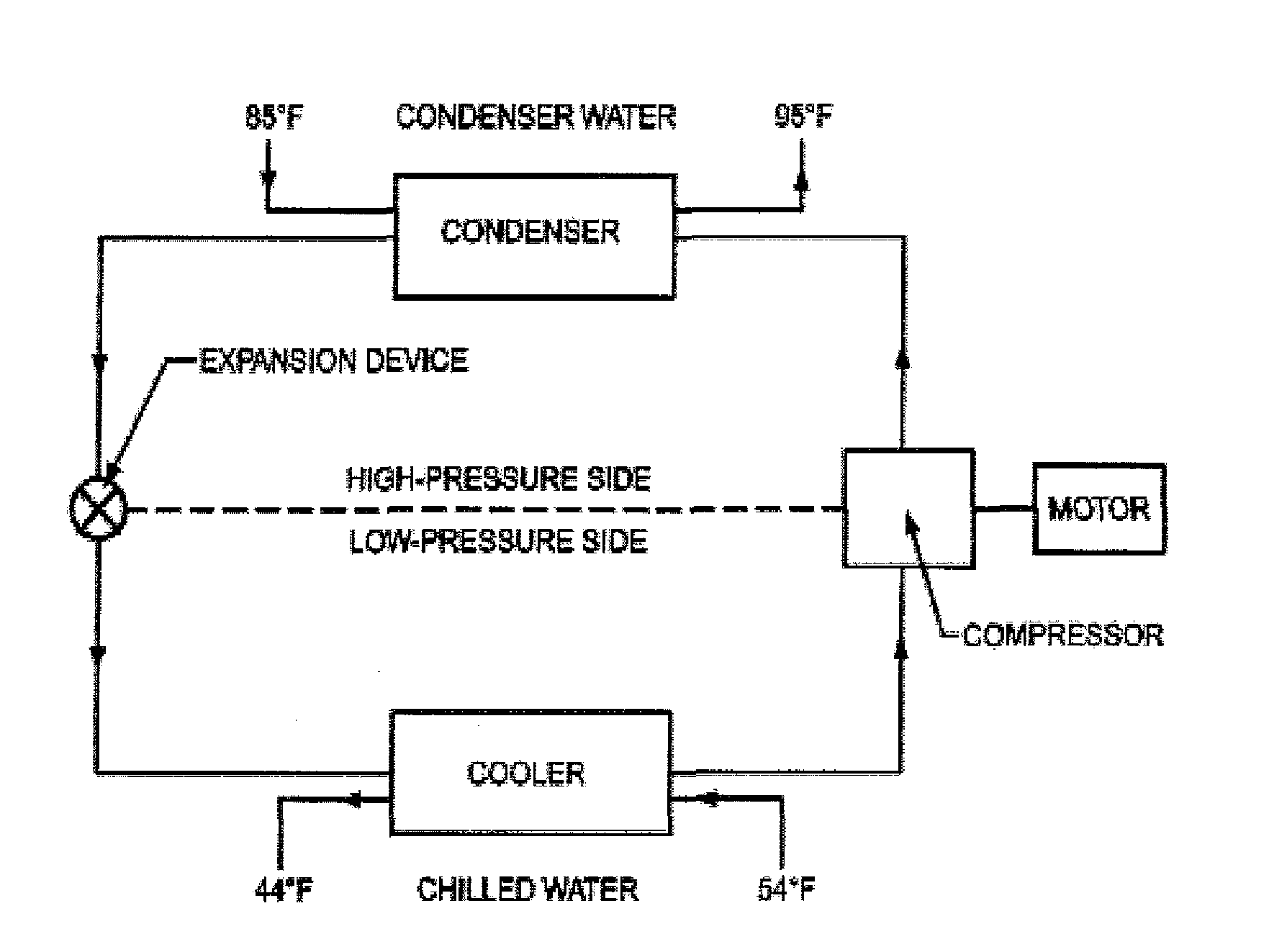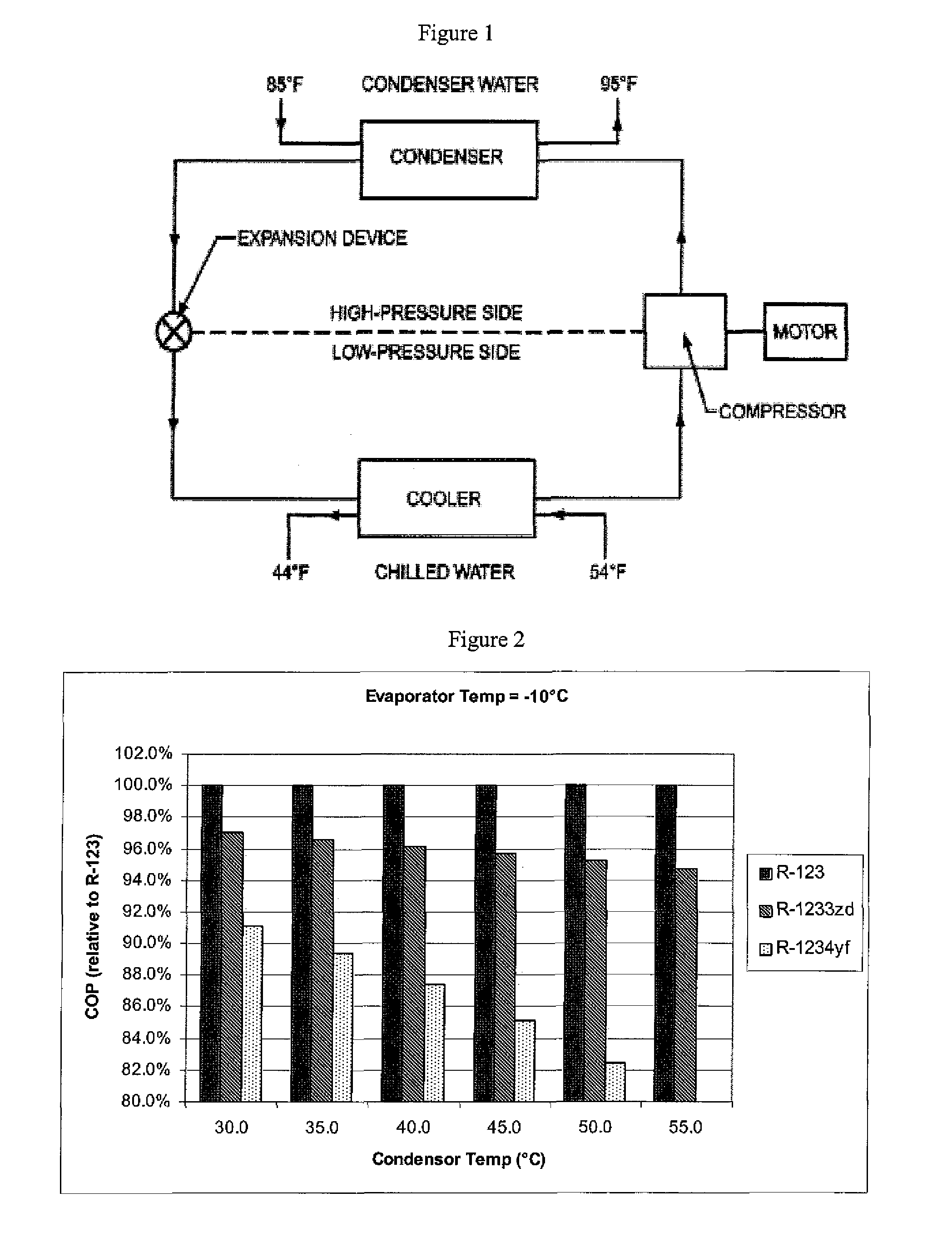Use of r-1233 in liquid chillers
a technology of chlorotrifluoropropene and liquid chiller, which is applied in the direction of refrigeration components, lighting and heating equipment, other chemical processes, etc., can solve the problem of air being sucked into the equipmen
- Summary
- Abstract
- Description
- Claims
- Application Information
AI Technical Summary
Benefits of technology
Problems solved by technology
Method used
Image
Examples
example 1
[0053]In this example, the following conditions were used:
[0054]Evaporator temperature=−10° C. Compressor inlet temperature=−5° C. Isentropic efficiency=0.7. The results are tabulated in Table 1.
[0055]FIGS. 2 and 3 show the COP and CAP of R-1233zd and R-1234ze relative to R-123.
TABLE 1T evap −10° C.Internal heat exchangerinlet compressor −5° C.isentropic efficiency 0.7Tcondevap Pcond PP diffP ratioCAP(° C.)(kPa)(kPa)(kPa)(p / p)(KJ / m3)COPR-1234yf30.02197725543.5314563.635.02198826634.0313723.140.021910037854.5812872.745.021911379185.1912002.350.0219128310645.8611112.055.0219144312246.5910191.7R-1233zd30.0281551275.512803.935.0281841566.542693.440.0282171897.712572.945.0282542269.042452.650.02829626810.522332.355.02834331412.182222.1R-12330.020110905.442064.035.0201311116.471993.540.0201551357.661923.145.0201821629.001842.750.02021319210.521772.455.02024722712.231692.2
example 2
[0056]In this example, the following conditions were used:
[0057]Evaporator temperature=0° C. Compressor inlet temperature=5° C. Isentropic efficiency=0.7. The results are tabulated in Table 2.
[0058]FIGS. 4 and 5 show the COP and CAP of R-1233zd and R-1234ze relative to R-123.
TABLE 2T evap 0° C.Internal heat exchangerinlet compressor 5° C.isentropic efficiency 0.7Tcondevap Pcond PP diffP ratioCAP(° C.)(kPa)(kPa)(kPa)(p / p)(KJ / m3)COPR-1234yf30.03127724612.4821525.335.03128825702.8320354.440.031210036913.2219153.745.031211378253.6417933.150.031212839714.1116682.755.0312144311314.6215402.3R-1233zd30.0461551093.374635.635.0461841384.004444.740.0462171714.724264.045.0462542085.534073.550.0462962506.433893.055.0463432977.453702.7R-12330.033110773.363375.735.033131984.003254.840.0331551224.743144.145.0331821495.573023.650.0332131806.512903.155.0332472157.562792.8
example 3
[0059]In this example, the following conditions were used:
[0060]Evaporator temperature=5° C. Compressor inlet temperature=10° C. Isentropic efficiency=0.7. The results are tabulated in Table 3.
[0061]FIGS. 6 and 7 show the COP and CAP of R-1233zd and R-1234ze relative to R-123.
TABLE 3T evap 5° C.Internal heat exchangerinlet compressor 10° C.isentropic efficiency 0.7Tcondevap Pcond PP diffT-outCAP(° C.)(kPa)(kPa)(kPa)comp(KJ / m3)COPR-1234yf30.03687724043926106.735.03688825144524725.440.036810036355123324.445.036811367685621883.7R-1233zd30.05815496445857.035.058183125505625.740.058216158555394.845.058254196615164.1R-12330.04111069444237.235.04113190504095.840.041155114563954.945.041182141613814.2
PUM
| Property | Measurement | Unit |
|---|---|---|
| temperature | aaaaa | aaaaa |
| boiling point | aaaaa | aaaaa |
| boiling point | aaaaa | aaaaa |
Abstract
Description
Claims
Application Information
 Login to View More
Login to View More - R&D
- Intellectual Property
- Life Sciences
- Materials
- Tech Scout
- Unparalleled Data Quality
- Higher Quality Content
- 60% Fewer Hallucinations
Browse by: Latest US Patents, China's latest patents, Technical Efficacy Thesaurus, Application Domain, Technology Topic, Popular Technical Reports.
© 2025 PatSnap. All rights reserved.Legal|Privacy policy|Modern Slavery Act Transparency Statement|Sitemap|About US| Contact US: help@patsnap.com



